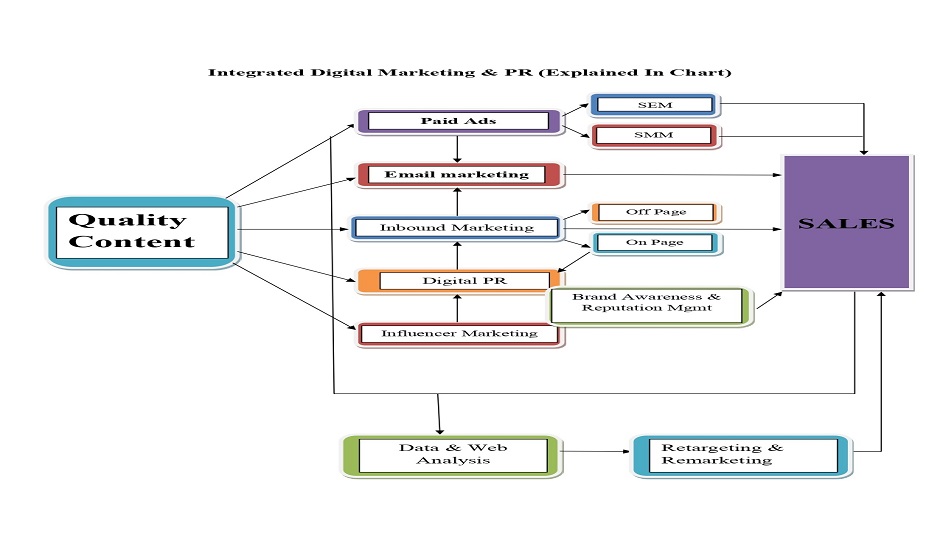ResQore Technologies’ Approach To Integrated Digital Marketing
At ResQore Technologies, we believe that a successful digital marketing strategy requires a seamless integration of various marketing channels and techniques. Our approach ensures that all efforts work together harmoniously to amplify their impact and maximize return on investment (ROI). By combining outbound marketing, inbound marketing, and comprehensive reporting and analysis, we create a robust strategy that drives traffic, generates leads, and fosters customer engagement.

Integrated Digital Marketing Process
Outbound Marketing (Paid Campaigns)
- Audience Targeting:Identify and define target audience segments based on demographics, interests, and online behavior. Use advanced targeting options available on advertising platforms to reach specific audience groups.
- Ad Creation:Develop compelling and visually appealing ad creatives. Craft engaging ad copy that highlights the unique selling points (USPs) of the product or service.
- Platform Selection:Choose appropriate advertising platforms (e.g., Google Ads, Facebook Ads, LinkedIn Ads) based on the target audience and campaign objectives. Utilize different ad formats to maximize reach and engagement. Every business is unique, and so should be its website. We offer custom design solutions that reflect your brand identity and set you apart from the competition.
- Campaign Setup:Configure ad campaigns with precise targeting parameters, budgets, and bidding strategies. Set up tracking mechanisms to monitor ad performance and conversions.
- Optimization and Monitoring:Continuously monitor campaign performance using analytics tools. Adjust targeting, ad creatives, and bidding strategies based on performance data. A/B test different ad variations to identify the most effective combinations.
Inbound Marketing (Generating Organic Traffic/Leads/Customers)
- Content Strategy:Develop a comprehensive content strategy that aligns with the target audience’s interests and pain points. Create high-quality, informative, and engaging content (e.g., blog posts, articles, videos, infographics, eBooks).
- SEO Optimization:Conduct keyword research to identify relevant search terms. Optimize website content, meta tags, and URLs to improve search engine rankings. Implement on-page and off-page SEO techniques, including internal linking, backlink building, and social sharing.
- Social Media Engagement:Build a strong social media presence on platforms where the target audience is active. Share valuable content regularly, engage with followers, and participate in relevant conversations. Use social media listening tools to monitor brand mentions and respond to customer feedback.
- Email Marketing:Develop targeted email campaigns to nurture leads and keep existing customers engaged. Segment email lists based on customer preferences and behavior to deliver personalized content. Use automated email sequences to guide leads through the sales funnel.
- Lead Generation and Nurturing:Create compelling lead magnets (e.g., free guides, webinars, case studies) to attract potential customers. Implement lead capture forms and landing pages to collect contact information. Use marketing automation tools to nurture leads with personalized content and offers.
Reports: Data & Web Analysis
- Data Collection:Implement tracking mechanisms (e.g., Google Analytics) to collect data on website traffic, user behavior, and conversions. Use UTM parameters to track the performance of individual campaigns and traffic sources.
- Performance Metrics:Monitor key performance indicators (KPIs) such as website traffic, bounce rate, average session duration, and conversion rate. Track the performance of paid campaigns, including click-through rates (CTR), cost per click (CPC), and return on ad spend (ROAS).
- Customer Insights:Analyze customer demographics, behavior, and preferences to gain insights into their needs and motivations. Use data segmentation to understand the performance of different audience segments.
- Campaign Analysis:Evaluate the effectiveness of inbound and outbound marketing campaigns based on performance data. Identify successful strategies and areas for improvement.
- Reporting:Generate regular reports providing a comprehensive overview of digital marketing performance. Use visualizations (e.g., charts, graphs) to present data. Share insights and recommendations with stakeholders to inform strategic decision-making.
- Continuous Improvement:Use data-driven insights to refine marketing strategies and tactics continuously. Implement changes based on analysis to improve performance and achieve better results.
